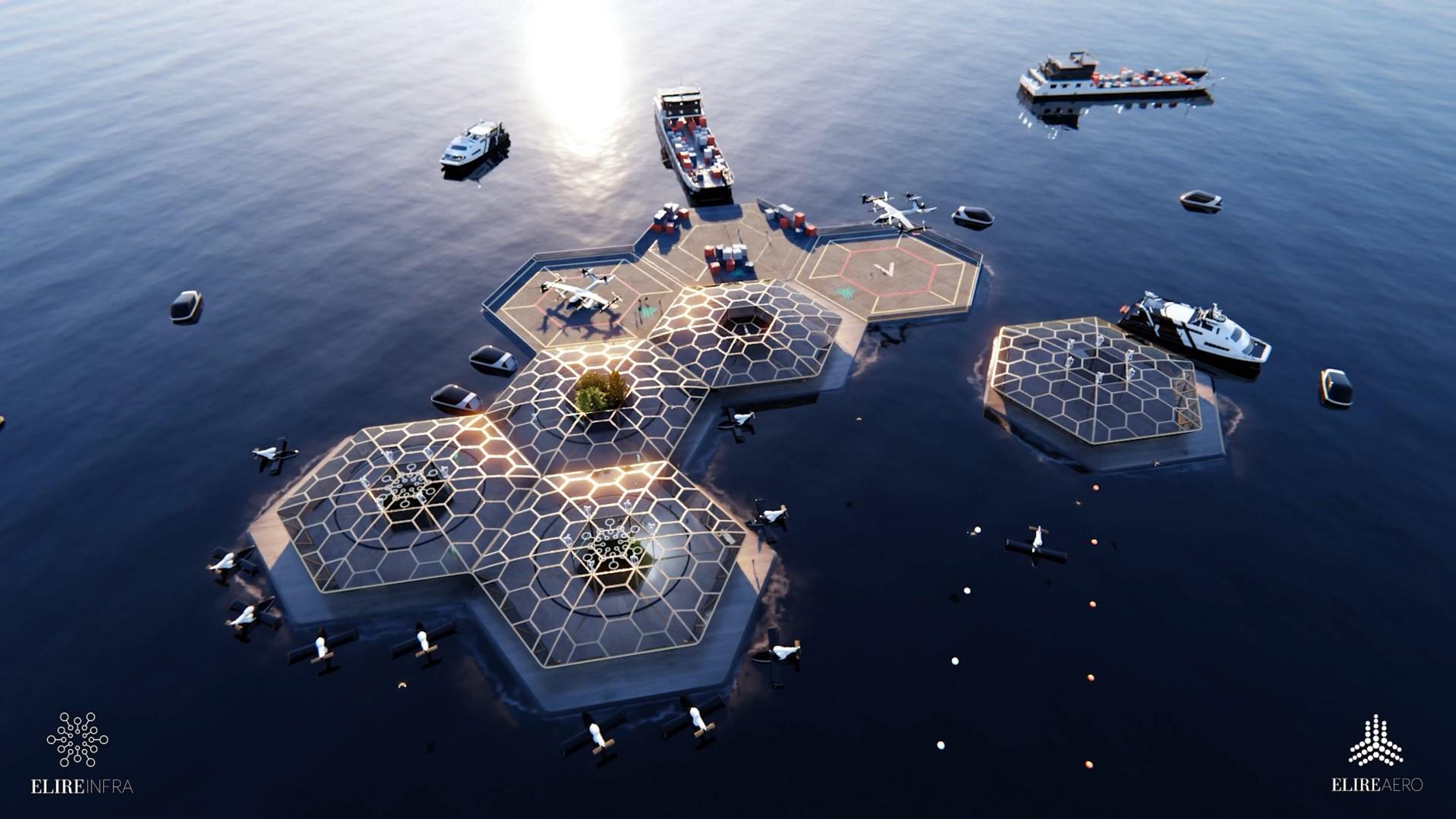
Elire Group’s planned multimodal floating mobility hubs are comprised of interchangeable hexagonally shaped modules that can be used for a variety of purposes like energy storage or passenger terminals.
Much of the focus on building out infrastructure for electric vertical takeoff and landing (eVTOL) vehicles has been aimed at congested cities and rooftop vertiports, but London-based startup Elire Group believes that maritime ports, harbors and other bodies of water could offer an even better alternative to dense urban environments.
As part of that vision, the company has released its plan for “blue” and “green” multimodal smart hubs on water and land, respectively, that could be easily constructed, deconstructed and transported in standard-sized shipping containers, allowing for a myriad of mobility options ranging from eVTOLs to maritime vessels, helicopters and drones.
“As opposed to trying to do this all on top of buildings, flying over water is much safer when you’re moving people or cargo or when you’re refueling,” Elire Group Managing Director Luke Jenkinson tells Aviation Week. “We don’t think it’s realistic to have many thousands of these eVTOLs flying around over cities. What we’re suggesting is that there needs to be real infrastructure for advanced air mobility [AAM] which should be floating, where you have greater access to cities using ports and harbors, and a safe pathway of traveling that’s over water.”
Central to the concept of the vehicle-agnostic floating mobility hubs are the hexagonally shaped modules that combine into clusters to form floating or land-based complexes of various shapes and sizes. Made of concrete and steel, the modules are essentially interchangeable and can be used for energy bunkers, passenger terminals, cargo storages or other applications, with eVTOLs and other aircraft able to take off and land from the tops of each unit.
“Once eVTOLs are available, they can just integrate into this infrastructure; there will be no need to build vertiports specific for the actual vehicle,” Jenkinson says. He notes that the multimodal nature of the hubs will be much more economically viable for municipalities and private owners compared to single-purpose vertiports. “This blows that whole business model away,” he adds.
The hexagonal units are each made up of six large pontoons with a nucleus in the center that houses electrical cables, water pipes and smart technology. The six pontoons can be easily deconstructed, with the components then placed into a shipping container and transported to other locations.
The goal is to lease out the mobility hubs for 30-year terms to governments, municipalities and private clients, Jenkinson says. He added that Elire is currently in the process of signing several MoUs with potential customers—each of whom would receive two prototype hubs to test and operate for a two-year trial period. “Then they basically would become the owners and get to use the hubs however they like for the next 28 years,” he says.
In tandem with Elire’s push into advanced mobility concepts, the group’s aerospace division is also developing an electric propulsion retrofit system for light conventional and short takeoff and landing aircraft. As part of that effort, the company plans to acquire a distressed airframer, although Jenkinson declined to specify which company the firm is eyeing. The startup is also in advanced discussions with hybrid-propulsion specialists MagniX and Ampaire and is in the process of hammering out MoUs with both companies, Jenkinson says.
“Once we acquire the airframer, we’ll go from being basically incognito to right up there with the likes of ZeroAvia and Pipistrel and those players that want to certify their electric aircraft by 2025,” he says.
As part of Elire’s business strategy, the company believes that retrofitting conventional aircraft with advanced propulsion will be the fastest and most straightforward way to achieve certification from regulators.
“We believe there’s suitable aircraft in the world at the moment that can be basically retrofitted and converted for this transition,” Jenkinson says. “The aviation industry wants to work toward zero emission, and the fastest, easiest and most sensible way to do that is through current conversions.”
